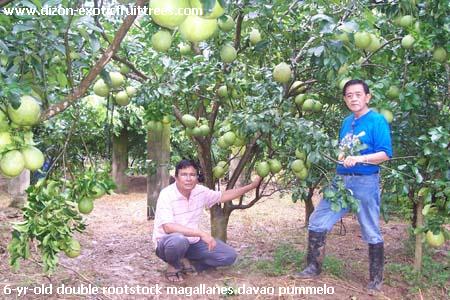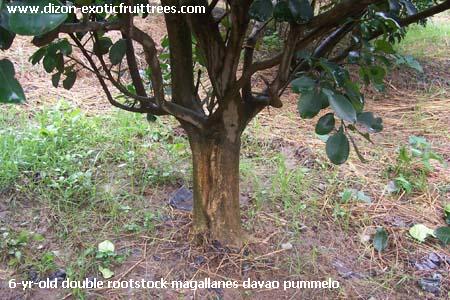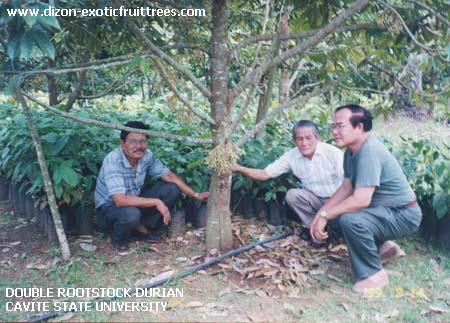| The
root system is the basic foundation of plants. It consists
of a primary root used for anchorage and lateral roots with
hairs that absorb water and nutrients; and oxygen for
respiration.
Plant's growth depends solely on root development,
which normally takes years before attaining
productive or fruiting stage. This growth phenomenon
is generally observed throughout the world
especially in temperate countries |
 |
 |
that
have two dormant seasons, autumn and winter. When the roots
are injured or diseased, there will be no growth. As the
roots grow, corresponding growth shall also be observed on
the upper portion of the plant. Therefore, if a plant has
more developed root system, its growth will be accelerated,
thus, enhance physiological maturity and early fruiting. |
| |
|
Multiple
rootstock or multi-root system is the growing of plants with
two or more rootstocks. Fruit exporting countries like
Taiwan, Thailand and Australia are practicing this
technique.
Mr. Rush of Balibago, of Clark Airbase, Pampanga revealed
that his late father, a professor in the University of
Michigan U.S.A., had used the multiple rootstock technology
in his plantations of oranges and apples since the early
60's.
In the Philippines, Engr. Telesforo L. Umali and his
late brother National Scientist Dean Dioscoro L. Umali of
U.P. Los Baños pioneered multiple rootstocking. Engr. Umali
regularly harvests fruits twice a year from his triple
rootstock durian and rambutan that were planted way back in
1980 in Scout Borromeo, QC.
Mr. Ramon Cua, a businessman, observed in Taiwan that
lychees and other fruit trees had double or triple
rootstocks making the tree prolific. A Taiwanese consultant
friend of Mr. Cua first introduced double and triple
rootstocking of calamansi and passion fruit in Cavite during
the early's '80s.
In
Negros, mango orchard growers regard double rootstock as
'turbo charged' technology because mango trees immediately
'take off from the ground with double growth compared to
single rootstock.'
In India, where more than 60% of total mango production
in the world came from, the multiple rootstock technology is
a common practice. Even rocks are blasted with dynamite and
filled with soil to have more space to plant double
rootstock mango.
|
Published Articles |
|
Growing imported fruit tree made easy
|
|
Manila
Bulletin, Tuesday, December 25, 1990
|
|
Experts Bats for multiple rootstock
|
|
Manila
Bulletin, Friday, May 3, 1991
|
|
The promise of multiple rootstock
technology |
|
The
Philippine Star, Business, Sunday, June
6, 2004 |
|
Multi-rootstock technology improves
productivity |
|
The
Philippine Star, Business, Sunday,
November 21, 2004 |
|
 |
Among state universities that practice multiple
rootstock technology, the Cavite State University in Indang,
Cavite successfully showcased exotic fruit trees such as
lychee, durian, rambutan, lanzones and many more. These
trees are now producing fruits in commercial quantity. |
|
Published Articles |
|
Durian in Silang
|
|
Manila
Bulletin, Agriculture, Thursday, March
18, 1999 |
|
Double rootstock mango for lahar areas
|
|
Manila
Bulletin, Agriculture, Thursday,
February 19, 2004 |
|
Mango with Double Rootstock Grows Faster
|
|
Agriculture
Magazine, March 2000 |
|
Durian can be grown, made productive
anywhere in RP - Multiple rootstock
technology makes this possible |
|
Philippine
Daily Inquirer, Thursday, December 31,
1992 |
|
At CLSU-Dizon Fruit Research and Techno-Demo Center,
multiple rootstock lychee, durian, rambutan, lanzones,
Magallanes Davao pummelo, oranges, Guimaras carabao and
imported mangoes, and other exotic fruit trees are all
growing and fruiting well.
DWWW
Station Manager Bert Bascal planted 500 single rootstock
Carabao mangoes in Sta. Cruz, Zambales upon the advice of
his consultant. His supplier of seedlings gifted him with
five double or triple rootstock of the same variety after 1
1/2 years when the nurseryman turned over the planted
Carabao mango. The multi-stock mango (3 1/2 years old) is
almost double in growth and yield compared to the five-year
old single rootstock mango.
According to Mr. Bascal, if he would have another
opportunity to plant, he would plant double or triple
rootstocks. He even suggested that he would plant the 3rd
rootstock deeper to have deeper anchorage and resist strong
typhoon.
Mr.
Bascal has requested Bernie Dizon to anchor "Tayo'y Magtanim"
program over DWWW at 5:15 - 5:30 a.m. Monday to Friday in order to reach farmers
in the countryside for the dissemination of the latest
technology of modern farm practices. Costly mistakes can be
avoided if only farmers are informed; this is the rationale
behind it all. "Where were you when I was planting and
starting to plan?" Mr. Bascal asked Dizon.
In Tartaro in Sa Miguel, Bulacan at the farm of Ka Joe
Burgos "The Land", the six-year-old multiple rootstock
Carabao mango and the 12-year-old existing traditional
single rootstock now have the same size and crown. The
multiple rootstock 6-year-old mango produced more fruits and
prolific than the 12-year-old mango tree. It is also has
sturdy root system that withstand strong typhoon which has
toppled some of the existing nearby single rootstock mango
trees.
It has been observed that triple rootstocks mango, when
applied with the right amount of fertilizer and proper
irrigation, will produce flower without smudging or using
KNO3. In the case of multi-rootstock mango trees, if the
flowers are aborted, it will flower again in a matter of
weeks until fruits finally develop.
Durian also responds well with triple rootstock
technology as it bears fruits twice a year as long as it
gets adequate fertilizer and water.
Triple rootstock rambutan of Engr. Umali produces
fruits as early as the month of May and June where
traditionally planted rambutan just begun to flower and
second harvest in October.
With cloning and multiple rootstock technology and
different weather condition prevalent in the country, it is
now possible to have a year-round abundant supply of fruits
for the local and export market that will surely become the
backbone in uplifting the socio-economic status of the
Philippines.
|

